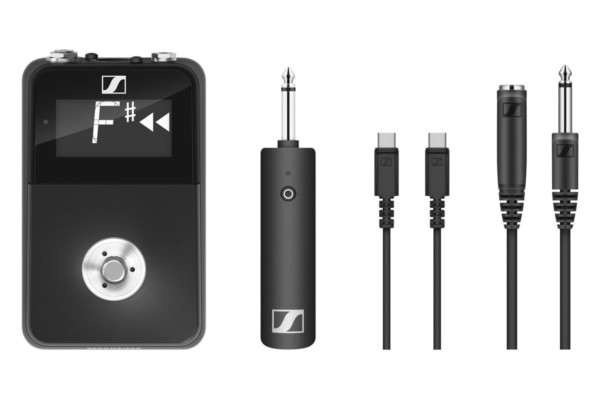Going Wireless: What to Look for in a Wireless System

Q: Every so often, I get a question and have no experience with the subject matter. Rather than ignoring it, I like to get someone else involved who can answer it better than I could. Case in point: I received a question some months ago asking about wireless systems and for suggestions as to what to look for and what they are best suited for. I have no idea! So I hit up my buddy Derek Frank. I’ve known him since my junior year in high school. He was the baddest dude in the school, and he still is. These days he’s an L.A.-based bassist who spends much of his time touring with Shania Twain, Mindi Abair and Air Supply! Nice… Needless to say, he’s used a wireless rig or two and has some great advice. Here are Derek’s thoughts on wireless rigs. After you read the column, check out some of his links below!
A: The great Nigel Tufnel once said to documentarian (or, “rockumentarian”, if you will) Marty DiBergi: “This is my radio unit… I strap this piece on, you know, right down in here when I’m on stage, and I can play without all the mucky-muck… It’s a wireless, exactly”.
Nigel, of course, was describing his wireless guitar system (and that was a reference to the movie “This Is Spinal Tap”, for all of you who have been living under a rock for the past 33 years). For many of us, that scene was our introduction to the idea that you could play guitar/bass without a cable, freeing us up to indeed move around the stage without all that, uh, “mucky-muck”.
I first started using wireless systems around 2006 when I began playing bigger stages/venues on pop/rock tours. Although I really enjoy the cool retro looks of the coil cables I’ve been known to use, I’ve grown to really appreciate the freedom that playing wireless has allowed me. Not to mention, from an audience perspective, it’s way more interesting to see a show where the players are moving around rather than standing in one place. I currently play bass with three different touring acts, and I’m wireless on all of them. I use a different system for each, so I’ll give you a breakdown of what each one’s all about. But first, let’s touch on the fundamental principles of wireless guitar systems.
A guitar wireless system always consists of two main parts: the transmitter and receiver. The transmitter is either in the form of a small rectangular pack that you hook onto your strap, belt, or pocket, or a very compact transmitter that simply plugs into your jack and has a small antenna attached. The transmitter converts your instrument’s analog signal into a digital signal that is then transmitted via radio frequency to a receiver (either mounted in a rack or attached to a pedalboard). The receiver of course “receives” the signal, converts it back to analog, and sends it to your pedalboard, amp, PA, etc. The frequencies used by guitar wireless systems are: VHF (Very High Frequency, 25MHz– 216MHz), UHF (Ultra High Frequency, 450MHz–955MHz), and 2.4GHz frequency bands. In the early days of guitar wireless systems, most used the VHF band, as UHF wireless systems were less common and more expensive. Today, there are VHF and UHF systems in practically all price brackets, and in recent years we’ve seen newer systems using the 2.4 GHz band, which was approved for guitar wireless systems by the FCC in the early 2000s. Most receivers today use “true diversity” technology, which combines two separate receiver sections, each with its own antenna. This allows the wireless unit to constantly compare incoming signals, and automatically select the stronger one. This makes for a much more stable and reliable signal, greatly reducing the risk of dropouts. Regardless of which frequency band your wireless system uses, one thing remains absolutely imperative: You need a clear channel in the right frequency in order to transmit your signal without interference. Finding a clear channel is done by “scanning”, which can be done either automatically or manually, depending on your system’s capabilities. Many modern systems will find a clear channel quickly and automatically, making things much easier for the player.
One thing to think about when choosing a wireless system is whether to get one that uses “companding” or not. Companding basically compresses your signal to squeeze it through the antenna, altering your tone as if you were using a very long cable. Sometimes this can result in a tone reminiscent of someone throwing a heavy wool blanket over your amp. Newer digital wireless systems such as those offered by Line 6 and Lectrosonics use compansion-free digital technology that gives the player a full-bandwidth digital transmission, thus preserving the original tone without any change in dynamics. The Line 6 Relay series even has a dial that mimics the amount of compression and high-frequency roll off that you would experience if you were using a cable… Turn it up to model a longer cable, turn it down to model a shorter cable, or turn it off to keep your tone absolutely uncolored. Another thing to think about is whether or not the unit you are looking at can handle the ultra-low frequencies of a detuned or 5-string bass. Look at the unit’s frequency response, which tells you what high and low frequencies the unit can handle. A low B on a 5-string rumbles at 32Hz, so make sure that that falls within the particular wireless system’s frequency response.
Obviously, there are many different systems available today, each with its own set of pros and cons. I’ll give you a basic rundown of the three different systems that I personally use, and hopefully, that’ll give you an idea of what could work for you. NOTE: I don’t officially endorse any of these companies or their products, so this is my unbiased report.
Gig 1: Mainly clubs and outdoor festivals, typically with small to medium-large stages. For this gig, I use a Line 6 Relay G50 wireless system. The Relay series units operate on the 2.4GHz band, are true diversity, and compansion-free. A very compact system, the G50 has a relatively small pedal-sized receiver that stays mounted on my pedalboard. As we do mostly one-off fly dates with this band, carrying our own gear, I’ve built a small pedalboard that I can stuff into my suitcase which then gets checked onto the plane. The Relay G50, with its compact pedalboard-friendly size, has worked out perfectly for me for this situation. It’s also very user-friendly; One of the guitarists that was formerly in this band used the same system… all we had to do to make sure our signals didn’t interfere with each other was choose different channels on the receiver dial. Piece of cake! I usually keep it in “low power” mode, which gives you limited range but preserves your battery life. I’ve had no problems covering smaller stages in low-power mode, but I’ll switch it to regular mode when we’re on bigger stages. On the less frequent occasions when we’re on a stage that has a “thrust”, or “catwalk”, I’ll sometimes notice that I can only walk out so far before experiencing dropouts. But those moments are somewhat rare…
Gig 2: Bigger stages than gig 1; mainly theaters, performing arts centers, and the occasional arena. On these shows, I use a Lectrosonics R400A that was provided for me when I joined the band (we have about six of these units, housed and transported in a rack). This is a digital UHF-based receiver which also uses true diversity and auto frequency selection. I’ve been using this system with this band for about a year now, with no issues… I’ve never experienced a dropout, and it’s handled my whole step-tuned-down 5-string (with a low A) like a champ.
Gig 3: Large arenas and outdoor festivals with huge stages and a thrust/catwalk. For this artist, we use Sennheiser Evolution Wireless systems, which are UHF, true diversity, have an auto-scan feature, and use digital compression which compresses and expands the signal without affecting the instrument’s tone. This unit can handle frequencies down to 25Hz, which hasn’t proven to be a problem for the low Bb’s that I play on my tritone-tuned-down 4-string (Bb Eb Ab Db). Again, these units are housed and transported in racks (I believe we have at least 8 of them). Of the three, this is the most expensive system… but you’re paying for peace of mind, knowing that you’ve got an ultra-reliable system that can handle lower-than-normal bass notes and won’t drop out when you walk out to the end of that thrust in true arena-rock fashion.
So there’s your crash course in guitar wireless systems! There are several great options out there, depending on your needs and budget. Do your research, find the perfect unit for your situation, and have fun running around the stage without the mucky-muck! No go out there and make Nigel proud.
– Derek Frank
Connect with Derek:
Have a question for Damian Erskine? Send it to [email protected]. Check out Damian’s instructional books, Right Hand Drive and The Improviser’s Path.



